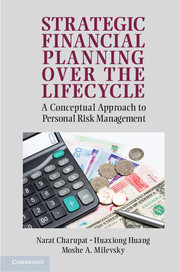Book contents
- Frontmatter
- Contents
- Acknowledgments
- 1 Introduction and Motivation
- 2 Mathematical Preliminaries – Working with Interest Rates
- 3 Personal Balance Sheet and Human Capital
- 4 Consumption Smoothing and Optimal Savings
- 5 Debts, Loans, and Mortgages [Canadian Content]
- 6 Personal Income Taxes [Canadian Content]
- 7 Risk, Utility, and Insurance
- 8 Mortality Risk and Life Insurance
- 9 Investment and Diversification
- 10 The Mathematics of Portfolio Diversification
- 11 Housing Decisions
- 12 Pensions and Retirement [Canadian Content]
- 13 Advanced Material: Part I. Continuous Time and the Calculus of Variations
- 14 Advanced Material: Part II. Stochastic Optimal Control and the HJB Equation
- 15 Concluding Thoughts and Next Steps
- Bibliography
- Index
6 - Personal Income Taxes [Canadian Content]
Published online by Cambridge University Press: 05 June 2012
- Frontmatter
- Contents
- Acknowledgments
- 1 Introduction and Motivation
- 2 Mathematical Preliminaries – Working with Interest Rates
- 3 Personal Balance Sheet and Human Capital
- 4 Consumption Smoothing and Optimal Savings
- 5 Debts, Loans, and Mortgages [Canadian Content]
- 6 Personal Income Taxes [Canadian Content]
- 7 Risk, Utility, and Insurance
- 8 Mortality Risk and Life Insurance
- 9 Investment and Diversification
- 10 The Mathematics of Portfolio Diversification
- 11 Housing Decisions
- 12 Pensions and Retirement [Canadian Content]
- 13 Advanced Material: Part I. Continuous Time and the Calculus of Variations
- 14 Advanced Material: Part II. Stochastic Optimal Control and the HJB Equation
- 15 Concluding Thoughts and Next Steps
- Bibliography
- Index
Summary
Learning Objectives
In this chapter, we will learn how to calculate personal income taxes. We then talk about different types of investment income and how they are taxed. Finally, we explore a few ways to minimize the amount of taxes that we have to pay.
The Logic of Income Tax Calculations
In this section, we describe how income taxes are determined in Canada. Generally, income taxes in other countries follow a similar logic. In Canada, income taxes are assessed at both the federal and provincial levels. You are required to file a tax return in a given (tax) year if for that year you are a resident or a deemed resident of Canada with income above a certain level. Whether or not a person is a resident of Canada is determined by many factors. These factors include the amount of time spent in Canada in that year, ownership of a residence in Canada, and having relatives, bank accounts, and/or other social and economic ties to Canada. Except for residents of the province of Quebec, which administers its own personal income tax collection, Canadians file their tax return using a combined form in which both levels of taxes are calculated.
As with most countries, Canadian incomes taxes (both federal and provincial) are determined using the following three steps:
Figure out your total income from all sources. In Canada, you have to report income earned from every source, domestic or foreign. From this, you subtract deductions that are allowed by the tax laws, to arrive at a taxable income.
You then apply (federal and provincial) tax rates to your taxable income. The result is the total tax amount.
Finally, you subtract tax credits from your total tax to arrive at the amount of tax payable.
- Type
- Chapter
- Information
- Strategic Financial Planning over the LifecycleA Conceptual Approach to Personal Risk Management, pp. 103 - 135Publisher: Cambridge University PressPrint publication year: 2012



